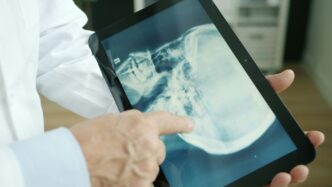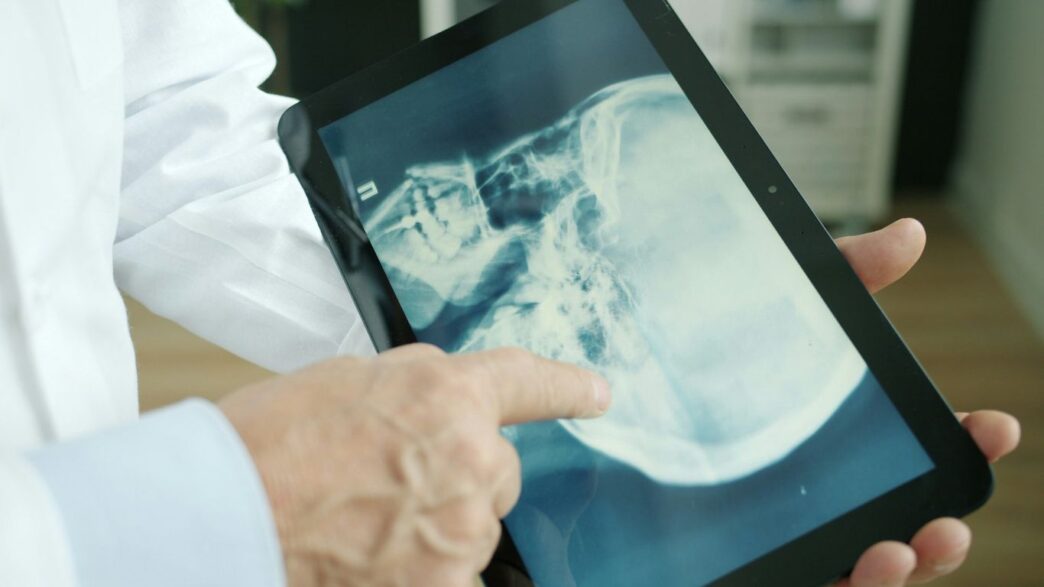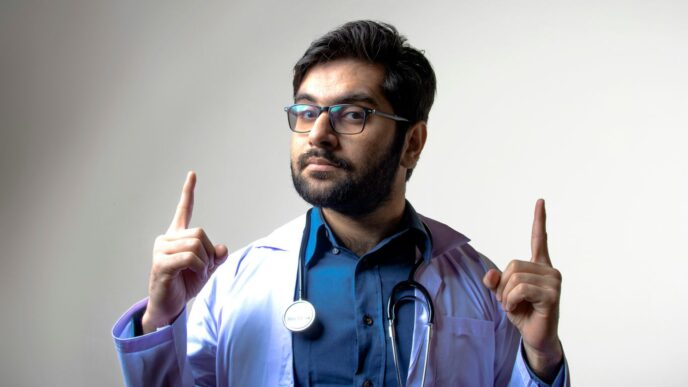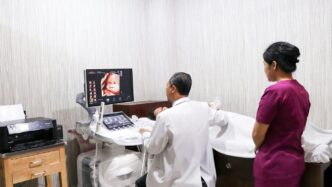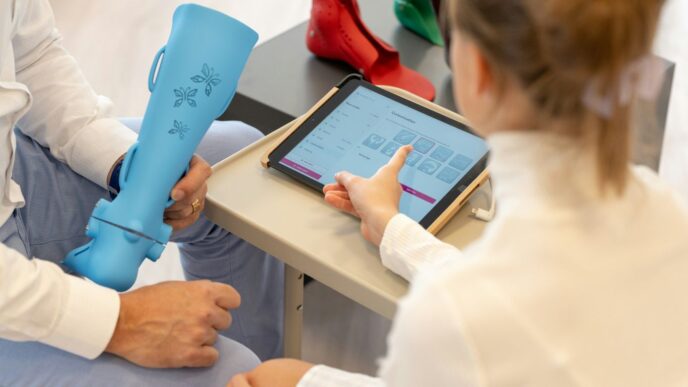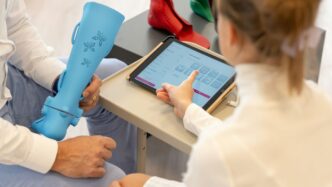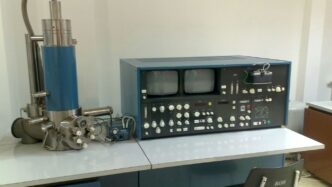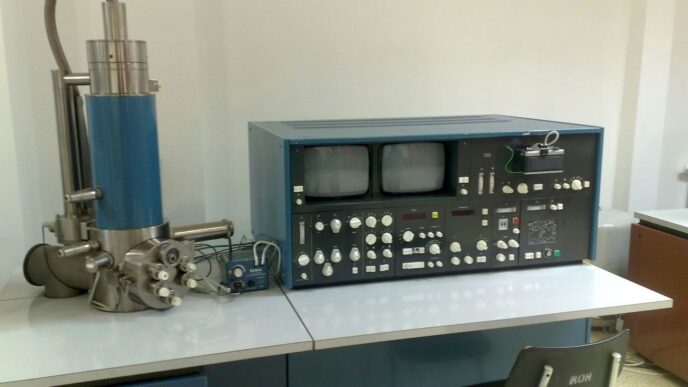Healthcare is changing, and a lot of that has to do with the Internet of Things, or IoT. Basically, it’s about connecting devices so they can share information. Think of it like giving your medical equipment and even your own body a way to talk to doctors and nurses. This connection is making things run smoother, giving patients more control, and helping doctors do their jobs better. We’re seeing a big shift towards smarter, more connected ways of managing health, and it’s all thanks to IoT in healthcare.
Key Takeaways
- IoT in healthcare means devices can talk to each other, sharing vital patient data in real-time.
- This connectivity helps nurses and doctors manage equipment better and makes hospital operations more efficient.
- Patients can take a more active role in their health with wearable devices that track their well-being.
- Remote monitoring and telehealth are becoming more common, making healthcare accessible to more people.
- IoT is paving the way for new innovations, like AI-powered health insights and personalized treatments.
Revolutionizing Patient Care Through IoT Connectivity
It feels like just yesterday we were talking about how computers would change hospitals, and now we’ve got this whole Internet of Things thing going on. It’s really changing how doctors and nurses do their jobs, and honestly, how we as patients experience healthcare. The biggest shift is moving from reactive care to something much more proactive, all thanks to connected devices.
Think about it. Instead of waiting for you to feel sick enough to come in, devices can keep an eye on things constantly. This means problems can be spotted way earlier. It’s like having a tiny health assistant working for you 24/7.
Enhancing Patient Monitoring with Real-Time Data
This is where IoT really shines. We’re talking about devices that can track your heart rate, blood pressure, oxygen levels, and even how well you’re sleeping. This information isn’t just sitting on the device; it’s sent straight to your doctor or care team. They can see trends over time, not just a snapshot from a single visit. This is super helpful for managing long-term conditions like diabetes or heart disease. If something looks off, they get an alert and can reach out before it becomes a big issue. It makes managing your health feel less like a guessing game and more like a well-informed plan. This kind of continuous oversight is a big step forward for patient care.
Here’s a quick look at what’s being monitored:
- Heart Rate
- Blood Pressure
- Blood Oxygen Levels
- Body Temperature
- Activity Levels
- Sleep Patterns
Empowering Patients with Active Health Management
It’s not just about doctors getting data; it’s about us, the patients, getting more involved. When you can see your own health stats, it’s a lot easier to make better choices. You might be more motivated to stick to an exercise plan if you see how it affects your heart rate, or adjust your diet if you notice your glucose levels spiking. These connected tools give us real-time feedback, making us active participants in our own well-being. It shifts the focus from just receiving treatment to actively managing our health day-to-day.
Streamlining Workflows for Improved Efficiency
Behind the scenes, IoT is also making life easier for healthcare staff. Imagine nurses not having to hunt for equipment because it’s all tracked. Or administrative tasks, like filling out compliance reports, being done automatically by sensors monitoring room conditions. This frees up valuable time. Instead of spending hours on paperwork or searching for supplies, staff can spend more time directly with patients. This makes the whole system run smoother and allows for more focused, quality care. It’s about making sure the technology supports the people providing the care, not getting in the way.
Transforming Healthcare Operations with IoT

Healthcare systems today are often bogged down by inefficiencies. Think about it: nurses hunting for equipment, paperwork piling up, and systems that just don’t talk to each other. It’s a recipe for delays and added costs, taking time away from what really matters – patient care. The Internet of Things (IoT) is stepping in to fix this, connecting devices and data in ways that make everything run smoother.
Optimizing Medical Equipment Management
Misplaced or underutilized medical equipment can be a real headache. IoT changes that. By attaching sensors to devices like infusion pumps or wheelchairs, hospitals can track their exact location in real-time. This means less time wasted searching and more time for clinical tasks. It also helps in understanding how often equipment is used, so resources can be allocated better.
- Real-time asset tracking: Know where your equipment is at all times.
- Usage analytics: Understand utilization patterns to optimize inventory.
- Automated check-ins: Devices can report their status and location automatically.
Automating Compliance Reporting Processes
Keeping up with regulations is a constant challenge. Manual reporting is time-consuming and prone to errors. IoT can automate many of these tasks. For example, environmental sensors in operating rooms can automatically log temperature and humidity, providing an auditable trail for compliance without manual intervention. Similarly, connected devices can log their own maintenance schedules and usage, simplifying record-keeping.
Minimizing Downtime Through Predictive Maintenance
Equipment failure can disrupt patient care and lead to expensive emergency repairs. IoT allows for a shift from reactive to proactive maintenance. Sensors on critical machinery can monitor performance metrics like vibration, temperature, and power consumption. By analyzing this data, systems can predict when a piece of equipment is likely to fail, allowing maintenance to be scheduled during off-peak hours before a breakdown occurs. This predictive approach keeps vital systems running and reduces unexpected costs.
| Equipment Type | Monitored Metrics | Predictive Action | Impact |
|---|---|---|---|
| MRI Machine | Vibration, Temp | Schedule service | Reduced downtime |
| Ventilator | Airflow, Pressure | Alert for filter | Improved patient safety |
| Sterilizer | Cycle time, Temp | Flag for calibration | Ensured sterility |
Advancing Medical Diagnostics and Treatment
It feels like every day there’s some new tech promising to change how doctors figure out what’s wrong and how they fix it. And honestly, a lot of it is pretty exciting. We’re moving beyond just guessing based on symptoms and into a world where data really talks.
Leveraging IoT for Personalized Medicine
Think about it: your body is unique, right? So why should your treatment be a one-size-fits-all deal? That’s where personalized medicine comes in, and IoT is a big part of making it happen. By collecting all sorts of data – from your genes to what you ate for breakfast, tracked by smart devices – doctors can get a much clearer picture of you. This means treatments can be fine-tuned just for you, making them more effective and cutting down on side effects. It’s like having a tailor-made suit instead of an off-the-rack one.
Enhancing Diagnostic Accuracy with Smart Devices
Remember when getting a diagnosis meant a bunch of tests and waiting around? Well, smart devices are changing that. Wearables can keep an eye on things like heart rate or blood sugar constantly, flagging issues way before you’d even notice them. Then there are advanced imaging tools that use AI to spot tiny details in scans that a human eye might miss. This means catching diseases earlier and more accurately. It’s not about replacing doctors, but giving them better tools to do their jobs.
Improving Treatment Adherence with Connected Tools
Sticking to a treatment plan can be tough. Life gets in the way, or maybe you forget a dose. Connected tools are stepping in to help. Smart pill bottles can remind you to take your medication and even let your doctor know if you’ve missed a dose. Apps can track your progress and offer support. For things like physical therapy, sensors can monitor your movements to make sure you’re doing the exercises correctly. The goal is to make sure patients get the most out of their treatment by helping them stay on track.
The Rise of Remote Healthcare with IoT
Revolutionizing Telemedicine Delivery
Remember when seeing a doctor meant a trip to the clinic, maybe even a whole day off work? Well, the Internet of Things (IoT) is changing that picture quite a bit. It’s making it way easier for doctors to check in on you without you having to leave your couch. Think about it: devices you wear or have at home are constantly sending information about your health – like your heart rate or blood pressure – straight to your doctor’s office. This means they can see if something’s off, even if you feel fine, and step in before a small issue becomes a big problem. This constant stream of data is a game-changer for how we get medical advice and care. It’s not just about convenience; it’s about getting the right help at the right time, no matter where you are.
Enabling Accessible Care for Underserved Communities
For folks living far from big hospitals or those who have trouble getting around, getting good healthcare can be a real challenge. IoT is stepping in to bridge that gap. By using connected devices, people in rural areas or those with mobility issues can have their health monitored remotely. This means they don’t have to travel long distances for regular check-ups. Doctors can keep an eye on chronic conditions, adjust treatments, and offer support from afar. It’s like bringing the clinic to their doorstep, making healthcare more available to everyone, not just those living in major cities. This technology helps level the playing field, giving more people a fair shot at staying healthy.
Facilitating Continuous Health Oversight
Beyond just appointments, IoT allows for something pretty amazing: continuous health oversight. Instead of just checking in now and then, your health can be watched over all the time. Wearable gadgets and home sensors collect data 24/7. This information paints a much clearer picture of your health trends over time. Doctors can spot subtle changes that might otherwise go unnoticed until a serious issue arises. This ongoing monitoring is particularly helpful for managing long-term illnesses like diabetes or heart disease. It allows for proactive adjustments to care plans, helping to prevent complications and keep people living healthier, more independent lives. It’s a shift from reacting to sickness to actively managing wellness.
IoT as a Catalyst for Healthcare Innovation
It’s pretty wild how much the Internet of Things (IoT) is shaking things up in healthcare, right? It’s not just about making things a bit more efficient; it’s really laying the groundwork for some seriously cool advancements. Think of it like this: IoT is gathering all this real-time information from devices, patient wearables, and even sensors around the hospital. This massive amount of data is exactly what advanced technologies like artificial intelligence (AI) and machine learning need to really get going.
Driving AI-Powered Insights in Healthcare
AI is hungry for data, and IoT is serving up a feast. When AI systems can look at information streaming from medical gadgets, fitness trackers, and environmental sensors, they start to spot patterns we’d never see. This means AI tools can help figure out the best times for appointments, making sure things run smoother and patients get seen quicker. Plus, with continuous monitoring from IoT devices, AI can flag early signs that someone might be getting sick, letting doctors step in before things get serious. It’s like having a super-smart assistant watching over everything.
Creating a Foundation for Advanced Technologies
Beyond just spotting problems, IoT data is changing how we think about treating people. Wearable devices that track things like heart rate, blood sugar, or how well someone is sleeping give doctors a much clearer picture of what’s working for each individual. This lets healthcare providers tweak treatments on the fly, making them more effective. Patients get more involved too, actively managing their health with these connected tools. This whole setup is paving the way for truly personalized medicine, where care is tailored specifically to you. It’s a big step from the one-size-fits-all approach we’ve had for ages. The potential for new medical breakthroughs is huge.
Enabling Smarter, More Sustainable Healthcare Ecosystems
And it’s not just about patient care; IoT is helping make healthcare operations more sustainable. By looking at data on energy use and resources, hospitals can find ways to cut down on waste and adopt greener practices. This helps meet bigger environmental goals, which is pretty important these days. Of course, getting all this set up isn’t always easy. There are worries about keeping data safe, the initial costs, and how complicated it might be to get everything working. But companies are working on solutions, like advanced security features and ways to show a clear return on investment. Pilot programs focusing on things like tracking equipment or automating reports can prove the value quickly. Plus, some systems are designed to be pretty straightforward to install, so they can be up and running in just a few weeks, making a difference right away. It’s all about building a connected system that’s not only efficient but also better for the planet.
Smart Wearables and Continuous Health Monitoring

You know, those little gadgets we wear on our wrists or clip onto our clothes are becoming way more than just fitness trackers. They’re turning into serious health tools. Smart wearables are changing how we keep an eye on our well-being by constantly collecting health information. Think about it – instead of just seeing your doctor once a year, you’ve got something on you that’s checking your heart rate, sleep patterns, and even blood oxygen levels all the time. This constant stream of data is a game-changer, especially for people dealing with long-term health issues.
It’s pretty neat how these devices work. They use tiny sensors to pick up on different body signals. This information then gets sent, usually through your phone, to an app or even directly to your doctor’s office. This means healthcare providers can spot problems much earlier than before. For example, if your heart rate suddenly spikes or drops unexpectedly, your doctor could get an alert and reach out to you. It’s like having a personal health assistant that never sleeps.
Here’s a look at some of the ways these wearables are making a difference:
- Early Detection: Spotting irregularities in vital signs like heart rhythm or blood pressure before they become major issues. This is super helpful for preventing heart attacks or strokes.
- Chronic Disease Management: For folks with conditions like diabetes or asthma, wearables can track things like glucose levels or inhaler use. This helps manage the condition better day-to-day and reduces the need for frequent clinic visits.
- Personalized Insights: The data collected gives you and your doctor a clearer picture of your health trends over time. This allows for more tailored advice and treatment plans that actually fit your lifestyle.
It’s not just about the big, serious stuff, either. These devices can also help you understand your sleep quality or stress levels, giving you practical information to make small changes that add up to better health. While there are still some hurdles to clear, like making sure the data is super accurate and keeping patient information private, it’s clear that smart wearables are a big part of the future of staying healthy.
Looking Ahead: The Connected Future of Care
So, what does all this mean for the future? It’s pretty clear that the Internet of Things isn’t just a passing trend in healthcare; it’s becoming a core part of how we get and give care. We’ve seen how it helps keep track of equipment, makes sure rooms are just right, and even lets doctors keep an eye on patients from afar. This tech is helping make things run smoother, which means healthcare workers can spend less time on paperwork and more time actually helping people. It’s about making healthcare smarter, more personal, and honestly, just better for everyone involved. The journey is ongoing, but the path forward is definitely connected.
Frequently Asked Questions
What is the Internet of Things (IoT) and how does it help in healthcare?
The Internet of Things, or IoT, is like giving everyday objects a brain and a voice. In healthcare, it means connecting medical devices, like monitors or even beds, to the internet. This lets them share information automatically, helping doctors and nurses keep a closer eye on patients and manage things more smoothly.
How does IoT help doctors monitor patients better?
IoT devices can constantly check things like a patient’s heart rate, temperature, or blood sugar. This information is sent straight to the doctor in real-time. So, if something looks wrong, they can find out right away and help the patient sooner, even if the patient is at home.
Can IoT help make healthcare more convenient for patients?
Yes! With IoT, you can often manage your health from home. Wearable devices, like smartwatches, can track your health, and doctors can check in with you through video calls. This means fewer trips to the doctor’s office, especially for people with ongoing health issues.
How does IoT improve the way hospitals work?
Hospitals can use IoT to keep track of important equipment, so it’s always where it needs to be and in good working order. It also helps automate tasks like reporting on safety conditions, freeing up staff to focus more on taking care of patients.
What is personalized medicine, and how does IoT help with it?
Personalized medicine means treatments are designed just for you, based on your unique health information. IoT devices collect a lot of specific data about your body and how you live. Doctors can use this detailed information to create the best possible treatment plan for you.
Is IoT making healthcare safer?
By providing real-time information and alerts, IoT helps catch health problems early. It also helps ensure medical equipment is working correctly and that hospital environments are safe. This all adds up to better care and fewer unexpected issues for patients.

